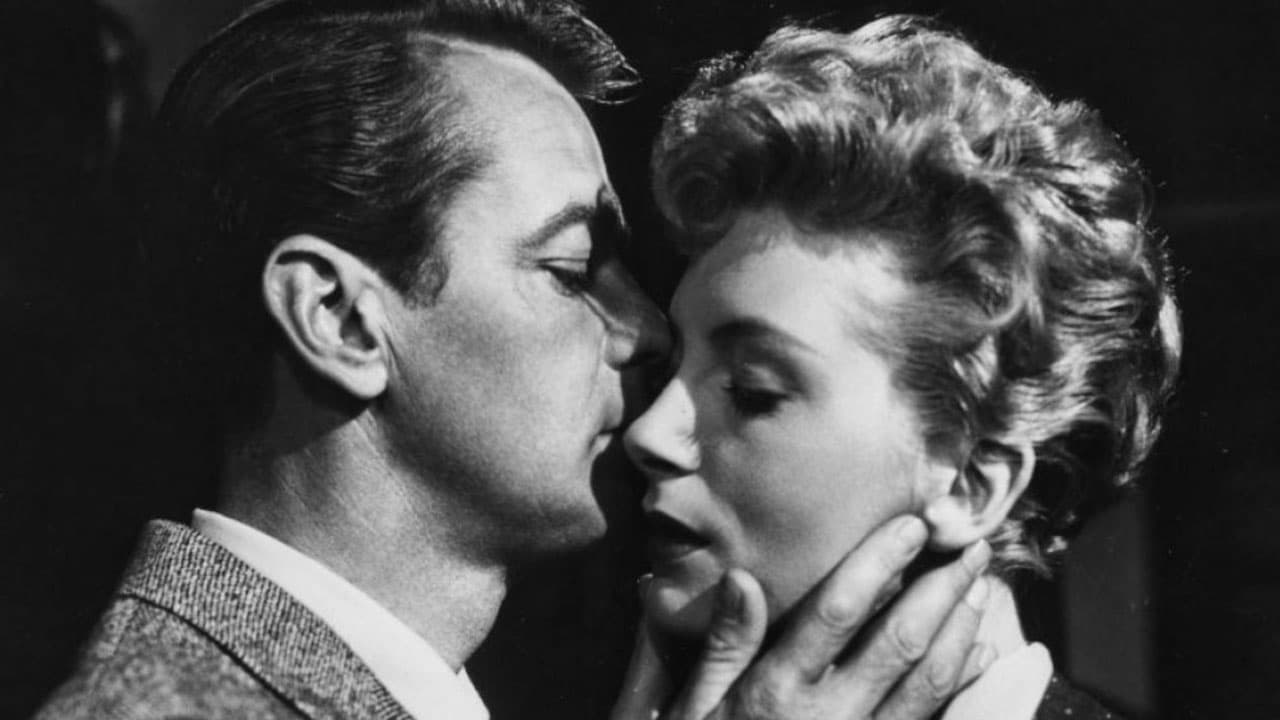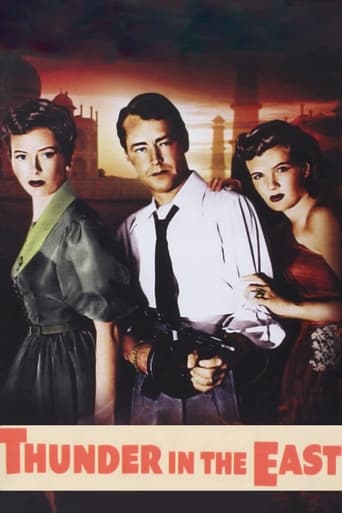

Overrated
... View Morejust watch it!
... View MoreFantastic!
... View MoreThere's a more than satisfactory amount of boom-boom in the movie's trim running time.
... View MoreThunder in the East (1952)If you like old Golden Age Hollywood movies you've seen a bunch of this kind of film by now. An American is overseas in an exotic place where people of various nationalities are finding various ways of surviving, some legit and some underground. The cross of cultures, and the rising of a new situation that threatens them all, is the basis of high drama and lots of new material. Think "The Letter" with Bette Davis, or much closer to the point, "Casablanca" with Humphrey Bogart.In that mold we have Alan Ladd as a gun runner, an American with no loyalties except money. The place is Ghandahar, a province in northern India, a country recently independent but with lot of Brits hanging on to their old ways (and made fun of a little). We presume this to be a Hindu controlled area, because there is a Muslim insurgency in the mountains. It's set in the 1947 and what politically is about to happen (and the audience in 1952 knows this) is the big breakup of the new India into two countries, with Muslim Pakistan born in the north.So Ladd drops into this tiny province with a plane full of armaments. He aims to sell them to the Hindu leader, played by Charles Boyer. But Boyer is a pacifist deep down and he refuses. By then it's too late to leave, and the insurgents are about to arrive, and worst and best of all, Ladd meets a woman, played by Deborah Kerr, who happens to be blind.This is both great stuff and also in danger of feeling contrived. For one thing, Ladd is no Bogart, and sometimes I think he thinks he is (he plays the hardboiled type who doesn't take advice from anyone). But the movie is no "Casablanca," either. It is however very good, with the romance and the military takeover jolting over rough territory. Kerr is a bright light here, a British woman born there and in love with the place, and with a better sense that the region is not theirs. Even so, she doesn't want to leave. And guess who has a plane?Well even that goes wrong (badly), and tensions build. The existence of the guns is an ongoing problem. Night comes. Their situation looks dire. And then, in a crazy Warner Bros. style ending that is worth every minute leading up to it, we have this amazing, ambiguous, catastrophic rising to action. It might not be reasonable, but then again, in a situation like this, it might be exactly what you'd expect. Or that there would be no choice. Either way, the camera shots in the final scene are terrific and surprising stuff.The director here is Charles Vidor, one of the long lived mainstays who made a lot of really good films but maybe no stellar ones (the best is probably the noir set in South America, "Gilda"). Vidor seems to be drawing from well used and still workable clichés to make the story vivid cinematically. It's actually a good ride. I happen to see that TCM viewers give it a very high composite score. I think this would be a terrible entry into older movies, but if you are already a fan, it's much better than you might expect. I give it a go.Oh, I realized after re-reading all this that the mythical Ghandahar is an homage to the pacifist Indian leader, Ghandi...a nice addition.
... View More"Thunder in the East" is a very rare film for Hollywood, as it concerns the turbulent time just after the British surrender of India in 1947. While the film never really explores the depth of the sectarian violence of the time (the northern part of India and East and West Pakistan became a bloodbath), it does talk about one small region in the north where the violence is headed--though the film fictionalizes this place and never discusses the religious divisions between Muslims and Hindus that led to the violence. But, at least it does discuss it--something oddly ignored in American films since an estimated 500,000 (or more--some estimates are much higher) were killed during this period. The transition from British to home rule was NOT a simple or bloodless process.The film begins with a pilot (Alan Ladd in his typical tough-guy role) landing in Ghandahar. He's not there on a mission of mercy--but to sell arms to the local government so they can beat off an anticipated attack by rebels. But, oddly, they are not particularly interested in the weapons and Ladd's quest for riches is frustrated. When he instead hopes to make money charging the Brits to leave in his plane, this plan also backfires and his plane is destroyed. What's to come of him, the locals and the British nationals? The film suffers from one huge problem as you watch---the Indian characters are NOT played by Indians but westerners (such as Charles Boyer and John Abbott). Now I understand that Hollywood did not have tons of Indians (the Asian type) readily available but couldn't they have used the ones they DID have available (such as Sabu) or imported some for the picture? This sort of silly ethnic casting was the norm at the time but seriously hurts the overall product. To me, it makes the film seem patronizing and false.Now if you can ignore this, how is the film otherwise? Is it entertaining? Well, it is...but Ladd pretty much plays the same grumbly, mercenary guy he played in most of his films. This guy in "Thunder in the East" is no Shane--just the usual grumpus who seems eternally perturbed and unable to smile. For Ladd fans (like myself), it is certainly a case of déjà vu despite the unusual setting--even with the romance between him and Deborah Kerr and his change of heart later in the film. Other folks NOT so familiar with Ladd would probably not notice this and would probably get more out of his somewhat stereotypical performance. The film is a decent drama nonetheless...and slightly better than just a time-passer--not that this is a glowing endorsement.By the way, during the 'payoff scene' (where Ladd decks a man), watch carefully. While the guy is NOT supposed to know that he's about to be slugged, you can clearly see the actor reacting BEFORE Ladd even delivers the punch! This shot should have been redone and is rather funny to see...but watch close! For a similar but even funnier mistake, see "North By Northwest" and pay close attention to the scene in the lodge near Mount Rushmore. A man is, completely unexpectedly, shot...yet an extra (some kid) has his fingers in his ears in anticipation of the gun firing!! I love seeing these sorts of goofs! And, by the way, in another Ladd film (the much better "Appointment With Danger"), Ladd also decks another guy (Jack Webb) in a similar fashion and the scene was done perfectly.
... View MoreParamount must have had some trepidations about Thunder in the East as it was made in 1949 and held up in release for three years. Nat King Cole recorded the theme from Thunder in the East, a song called The Ruby and the Pearl three years earlier. It's quite a beautiful ballad and perfectly suited for Cole's voice, it's the best thing to come out of this routine action film.Alan Ladd plays an arms dealer selling weaponry for the best price he can exact from the various sides in the Indian Civil War where the boundaries of India and Pakistan were settled in a lot of blood spilled. He's in Ghandahar province which has its rebel Moslem faction. He falls for Deborah Kerr the blind daughter of missionary Cecil Kellaway.Ladd's got a silly playboy maharajah in Charles Lung to deal with and a prime minister for Ghandahar who is a disciple of Gandhi's non-violence philosophy. Charles Boyer as the prime minister doesn't want the weapons, but the rebel Moslems want them if for no other reason than to keep them out of Hindu hands and if they can't buy them, they'll take them by whatever means necessary.The film tries to be a critique of Gandhi's non-violence code, but it doesn't rise above being an action/adventure story. The ending is a rather abrupt one and unconvincing. Still fans of the star players will probably like it.
... View MoreI guess the 1952 audience was certainly not satisfied with the ending,which abruptly comes as the heroes are still in action. Ending a movie like that was not obvious at the time.The biggest flaw is French actor Charles Boyer,ridiculously made up as a Hindu.This character,a Gandhi disciple, puts forward wisdom,prayers,peace and love to cowardice and reactionary mind (the English) greed(Alan Ladd's character) , violence (his brothers ,the rebels),and complete irresponsibility (the caricature of a maharajah).He's the only positive character of the story along with the minister and his blind niece (Kerr).It's absolutely impossible to believe Boyer is an Indian ,mainly if you've seen him as a French lover!Besides,he finally demonstrates the opposite of what he stood up for . Ladd's evolution is predictable,from a greedy businessman to a hero (thanks to the blind girl of course).One should notice that Deborah Kerr is too great an actress to play such a poor part that would be suitable for a B movie starlet.Her intellectual playing does not match with down-to-earth Alan Ladd.The movie also suffers from a shoestring budget.Take George Cukor's "Bhowani junction"(1956) instead.
... View More